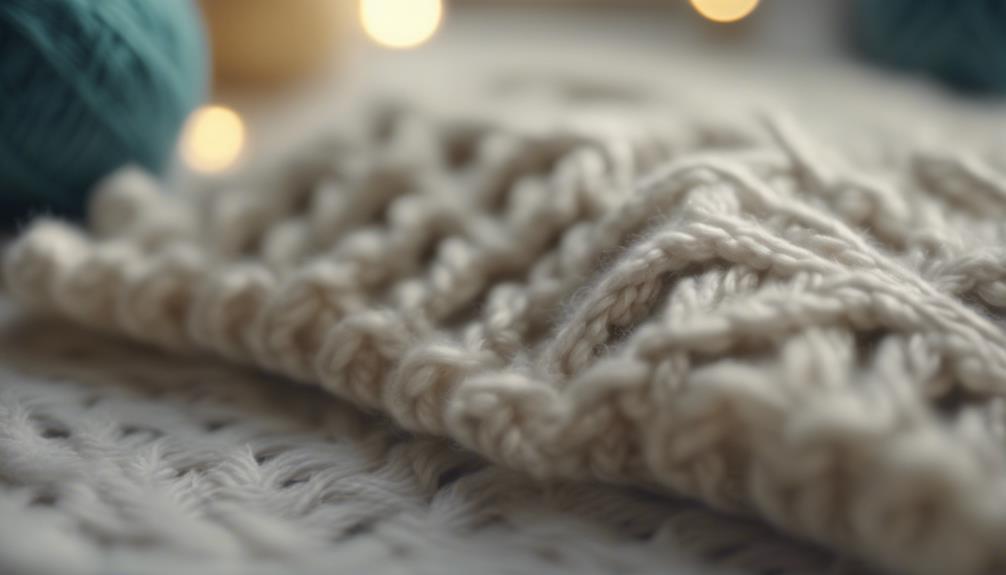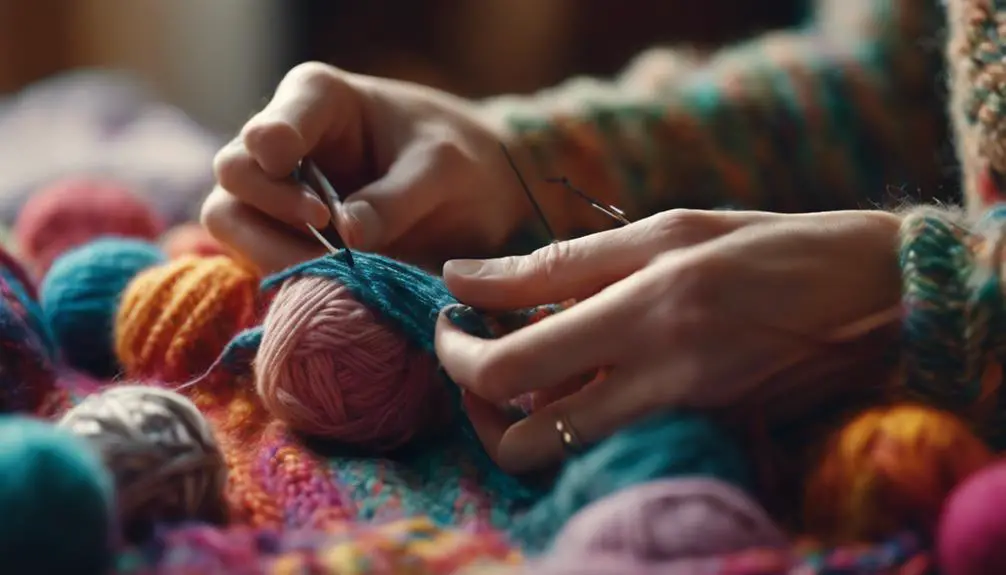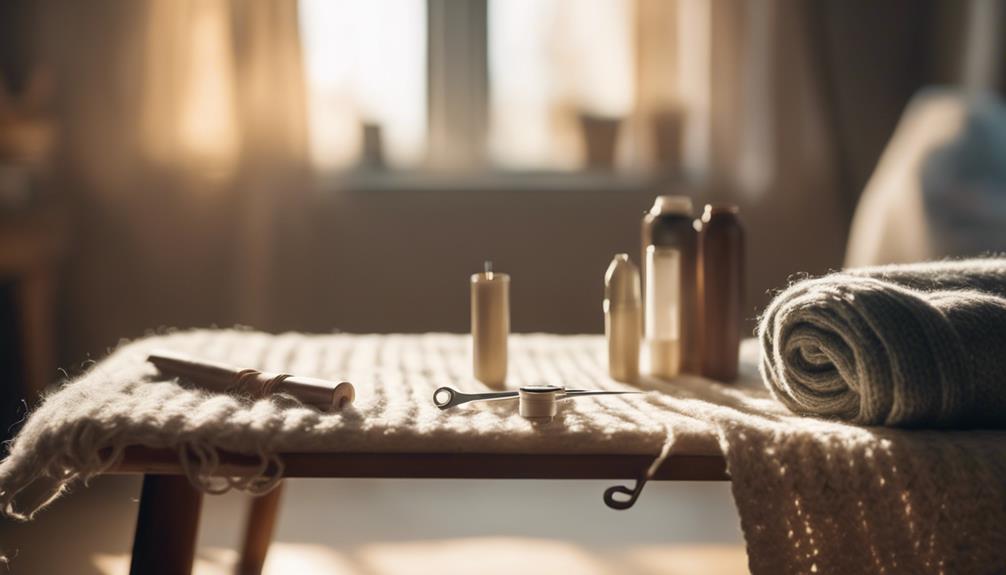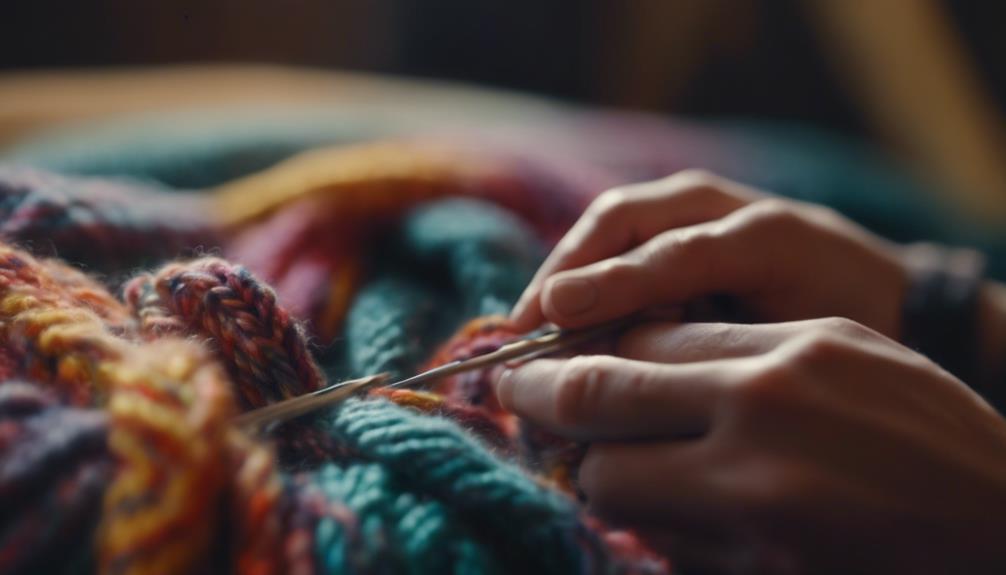To fix a snag in your knitwear, first, identify the snag type. Use a fine, sharp needle to gently realign pulled threads. If the snag has created a hole, employ darning techniques by stitching over the area with matching yarn. Utilize a darning egg or mushroom to maintain tension and ease the process. Tweezers can help pull loose fibers back into place. Always make sure to cut any excess threads with sharp scissors for a clean finish. Regular inspections can prevent future snags, and you might find valuable maintenance tips to keep your knitwear looking pristine.
Understanding Snags and Pulls

Understanding snags and pulls is essential for maintaining the quality of your knitwear. Snags occur when fibers are pulled from the surface of the fabric, while pulls arise from tension on the fabric, causing threads to shift. In knitwear, snags are particularly common due to the looped structure of the yarn, which makes it easy for fibers to catch on rough surfaces or sharp objects.
Common culprits for snags include velcro, jewelry with sharp edges, and playful interactions with pets. These factors can create unsightly pulls and snags that compromise the integrity of your garment.
To prevent these issues, handle your knitwear with care, avoiding contact with abrasive materials. Regular inspections of your garments help catch snags early, allowing for prompt attention before they worsen.
Proper storage is also vital; fold your knitwear instead of hanging it, as hanging can lead to stretching or friction that exacerbates snags.
Essential Repair Tools
When you're ready to tackle a snag in your knitwear, having the right tools on hand makes all the difference. Here's a quick list of essential repair tools you'll need:
- Fine, Sharp Needle: This is vital for maneuvering the delicate fibers without causing further damage. A finer needle guarantees a more precise repair.
- Matching Yarn: Always have yarn that matches both the color and texture of your knitwear. This guarantees your repair blends seamlessly with the surrounding fabric.
- Sharp Scissors: You'll need these for making clean cuts to remove any excess thread or to trim protruding loops that could lead to new snags.
Additionally, a darning egg or mushroom provides a firm surface, making it easier to manipulate the fabric during repairs.
Tweezers are also handy for delicately pulling loops back into place or weaving in loose ends without distorting the fabric.
Having these tools on standby won't only simplify the repair process but also enhance the longevity of your favorite knitwear.
Repair Techniques for Snags

With your repair tools ready, you can now focus on effective techniques for addressing snags in your knitwear. Start by evaluating the type of snag. If it's a pulled thread, gently pull it back into the fabric to realign the tension, reducing distortion. For more permanent fixes, consider weaving. Use a fine needle and matching yarn to thread loose fibers back into the knit structure, restoring integrity.
Darning is another excellent option. Create a patch over the snag using a darning stitch, which effectively secures loose threads and covers small holes. For a nearly invisible repair, try invisible mending, where you blend threads with the surrounding fabric, minimizing visibility.
Using a darning egg or mushroom can greatly aid your repairs, providing a firm surface that allows better manipulation of the fibers. Here's a quick comparison of techniques:
| Technique | Description | Best For |
|---|---|---|
| Weaving | Threading loose fibers back into the fabric | Structural repairs |
| Darning | Creating a patch over a snag | Covering holes |
| Invisible Mending | Blending threads with the fabric | Aesthetic repairs |
| Minor Snag Fix | Gently pulling a pulled thread back | Quick fixes |
Maintenance Tips for Knitwear
To keep your knitwear looking its best, regular maintenance is essential. By following these simple tips, you can prolong the life of your garments and minimize the risk of snags:
- Inspect Regularly: Frequently check your knitwear for snags and pulls. Catching these issues early will help you fix a snagged area before it worsens.
- Careful Washing: Always wash your knit garments in cold water on a delicate cycle. This reduces stress on the fibers, which lowers the risk of snagging during the wash.
- Proper Storage: Store your sweaters flat rather than hanging. Hanging can stretch the fabric and create snags due to gravity and friction.
Additionally, keep your knitwear away from rough surfaces and sharp objects. These can easily catch on your fabric and lead to snags.
When laundering, use garment bags to protect delicate knitwear from potential damage caused by other items in the wash.
Preventing Future Snags

Preventing future snags in your knitwear requires a proactive approach, focusing on both material choice and mindful usage. Start by selecting knitwear made from tightly woven fibers. Open weaves are more susceptible to snags, so opt for denser fabrics that can withstand daily wear and tear.
When storing your knitwear, always fold it neatly in a drawer or on a shelf. Hanging can lead to stretching and snagging on rough surfaces, compromising the integrity of the fabric.
Additionally, be cautious with jewelry; avoid wearing pieces with sharp edges that can easily catch on your knitwear and create snags.
Regular inspections are essential—check for loose threads or potential snags frequently. By addressing these issues promptly, you can prevent further damage to your garments.
When it comes time to wash your knitwear, use garment bags to shield them from friction and snagging caused by other items in the laundry.
When to Seek Professional Help
Often, knowing when to seek professional help for a snag in your knitwear can save you time and further damage to your garment. Here are three key scenarios where you should consider consulting an expert:
- Large Holes or Unraveling: If the snag has resulted in a significant hole or extensive unraveling, a professional can provide the expert repair needed to restore your knitwear effectively.
- Sentimental Items: For pieces with sentimental value, such as family heirlooms or cherished gifts, it's essential to preserve their integrity. Professional services guarantee careful handling and proper techniques.
- Complex Fabrics: If your knitwear is made from delicate materials like cashmere or features intricate hand-knit designs, specialized skills and tools may be necessary. Professionals are equipped to handle these complexities safely.
If you're uncertain about your DIY repair skills, lack the right tools, or find yourself pressed for time, seeking professional assistance is a smart choice.
It assures the best outcome for your garment and protects it from further snags or damage. Don't hesitate to reach out to an expert when you encounter these situations.
Frequently Asked Questions
Can a Snag Be Fixed?
Yes, a snag can be fixed. You can gently manipulate the fabric to realign fibers, using tools like a blunt needle or crochet hook to distribute tension evenly, thereby restoring your garment's appearance effectively.
How Do You Fix a Tight Snag?
To fix a tight snag, stretch the surrounding fabric gently, then use a fine needle to pull the snagged loop through to the backside. Inspect for even tension afterward to maintain your knitwear's integrity.
How Do You Fix a Snag on Stretchy Fabric?
To fix a snag on stretchy fabric, gently pull the snagged loop back using a blunt needle. Lay the fabric flat, ensuring good lighting, and weave in matching thread to restore its integrity and appearance.
How to Fix a Hole in a Fine Knit Sweater?
To fix a hole in your fine knit sweater, locate an intact stitch nearby. Use a fine needle and matching yarn to weave loose fibers, or employ darning techniques for a seamless repair that maintains fabric integrity.





Your article helped me a lot, is there any more related content? Thanks!